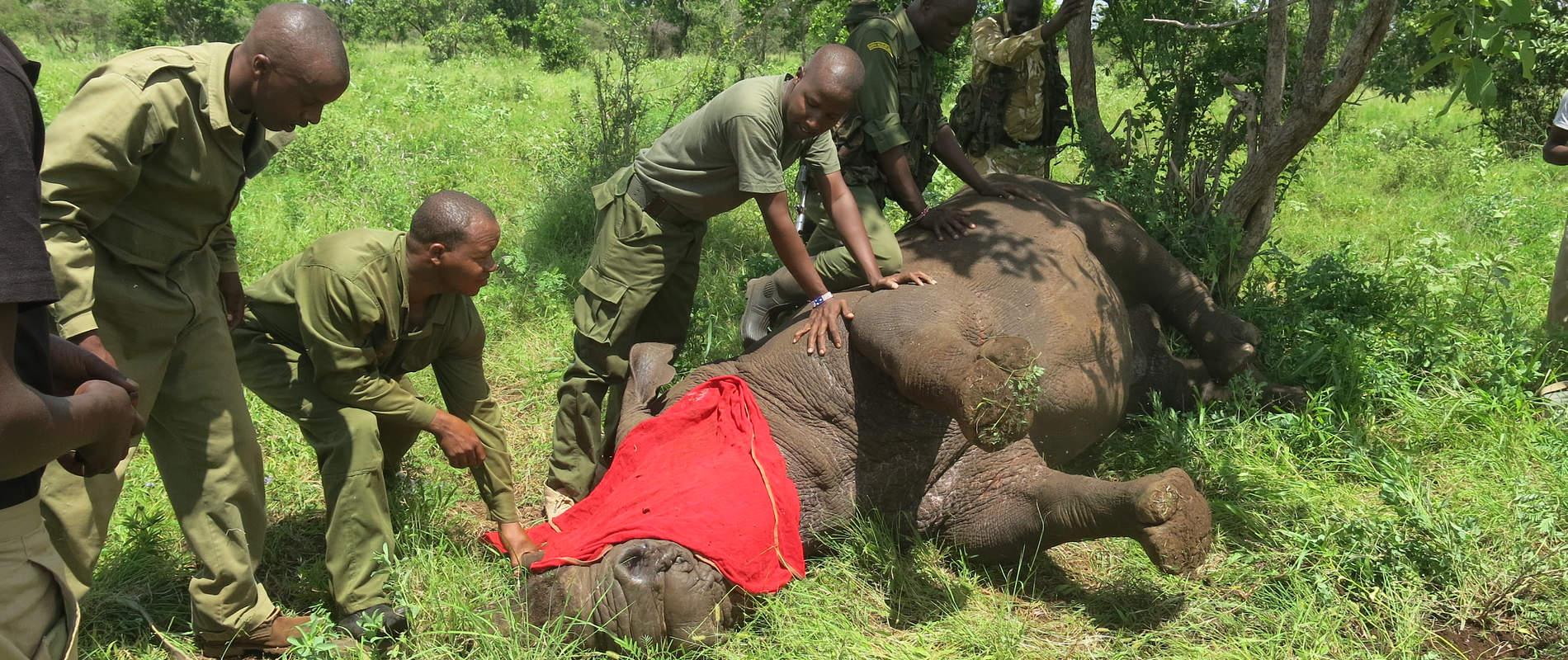SUMMARY This report describes activities of the Meru Veterinary Unit in December 2015
SUMMARY
This report describes activities of the Meru Veterinary Unit in December 2015.
In Ol Jogi ranch, Laikipia we removed a wire snare from an elephant calf which had inflicted a debilitating leg injury. In Meru National Park we treated a white rhino for soft tissue injury suffered in a territorial fight and removed a snare from the neck of a water buck.
The unit would like to acknowledge financial and logistical support from the David Sheldrick Wildlife Trust which has enabled treatment of injured wildlife in Northern Kenya.
CASE #1: DESNARING A WATER BUCK
Date: 4th December 2015
Species: Common water buck
Sex: Female
Age: Adult
Location: Meru National park, Mugwongwo plains
History
On the 4th December, tour guides from Elsas Kopje lodge reported that a water buck had a loose wire snare around its neck which needed to be removed.
Immobilization, examination and treatment
After a brief search in an area where it was seen earlier that day, this water buck was found near the road leading to Elsas Kopje lodge. It was in company of two calves and looked calm on approach.
The waterbuck was immobilized using a combination of M99 3mg and Stressnil 20mg in a single 1.5cc Dan-Inject dart from a vehicle. It went down in five minutes and a blind fold was applied to minimize stress.
The wire snare around its neck was loosened and removed.


Reversal
Reversal of anesthesia was achieved by intravenous injection of M5050 12mg through the superficial veins in the ear pinna. Two minutes later the water buck stumbled onto its feet and ran into the bush where it joined its two calves.
Prognosis
Because there was little trauma caused by the snare this water buck will make a complete recovery.


CASE #2: TREATMENT OF A WOUNDED WHITE RHINO
Date: 4th December 2015
Species: White rhino
Sex: Male
Age: Adult (≤ 20 years)
Location: Meru National park, Rhino sanctuary
History
On 2nd December, KWS rangers on patrol reported that this rhino had shown severe lameness and swelling on its hind leg. The officer in charge of the rhino requested for an assessment and treatment of its injuries.
Immobilization, examination and treatment
The rhino was immobilized using a combination of M99 5mg and Stressnil® 60mg in a single 3cc Dan-Inject dart with a 2.0 × 60mm needle from a helicopter. The dart was placed into the dorsal lumbar muscles. This rhino was roped to lateral recumbency after 9 minutes and a blind fold applied to minimize stress.


Patient monitoring during anesthesia was achieved by counting respiration rate and observation of mucous membranes for capillary refill. It was generally stable under anesthesia with an average of 4 breaths per minute while the mucous membranes were pink and moist.
Examination revealed skin lacerations to the ventral abdomen, perineal area and abdominal flanks. Hock joint of the left hind foot was swollen. Manipulation showed that the joint was stable therefore these injuries affected the soft tissue around the joint. These injuries were consistent with fight wounds.
The wounds were scrubbed, debrided and Povidone Iodine applied to clean and disinfect the wounds. FlunixinMeglumine an anti-inflammatory drug and a 20% Oxytetracycline hydrochloride an anti-microbial drug were injected intramuscularly.


Reversal
For anesthesia reversal, 5% NaltrexonHcl 150mg was given intravenously through the ear veins.

Prognosis
Two weeks after treatment this rhino was reported to have improved significantly.

CASE #3: DESNARING AN ELEPHANT CALF
Date: 11th December 2015
Species: Elephant
Sex: Female
Age: Juvenile (< 1 year)
Location: Ol Jogi ranch, Laikipia
History
Wildlife rangers in OlJogi ranch reported that an elephant calf had shown severe lameness and deep wounds caused by a snare on its right forelimb. The ranch security manager requested for immediate veterinary intervention to treat this calf.
Restraint, examination and treatment
After a brief aerial search, this calf was found in company of its mother in a herd of 7 elephants, mainly composed of sub-adult elephants. The herd looked calm on approach by vehicle. Its mother was darted to avoid separation after treatment while the calf was restrained physically using ropes.
Darting was done from a vehicle using 12mg M99 in a 1.5cc Dan-Inject dart. The rest of the herd was chased away using vehicles and the calf roped to lateral recumbency for treatment.


A wire snare had cut through the soft tissue distal to the carpal joint of the right forelimb causing debilitating contaminated wounds. Tissue necrosis, joint deformity and swelling was observed showing that these injuries were chronic.

The wire snare was cut using a wire cutter and removed carefully. The wound was debrided to remove necrotic tissue using Hydrogen peroxide and povidone Iodine. Green clay was then applied to facilitate healing. BetamoxTrihydrate 20ml and Flunixinmeglumine were injected intramuscularly.


Reversal
The anesthesia of the mother elephant was reversed by intravenous injection of Diprenophine hydrochloride 36mg. After 3 minutes she was conscious and was soon reunited with its calf and the rest of the herd which were waiting nearby.
Though its injuries were severe this calf is expected to make a slow recovery, permanent deformity of the leg is expected due to chronic injury. Follow up treatment will be scheduled to monitor the progress of this injured calf.



















